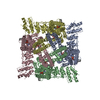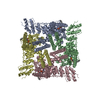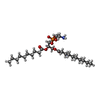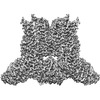+ Open data
Open data
- Basic information
Basic information
| Entry |  | |||||||||
|---|---|---|---|---|---|---|---|---|---|---|
| Title | Apo rat TRPV2 in nanodiscs, state 1 | |||||||||
 Map data Map data | State 1 of apo rat TRPV2 | |||||||||
 Sample Sample |
| |||||||||
 Keywords Keywords | Ion channel / TRP channel / Membrane protein / tetramer / TRANSPORT PROTEIN | |||||||||
| Function / homology |  Function and homology information Function and homology informationgrowth cone membrane / TRP channels / response to temperature stimulus / positive regulation of calcium ion import / endomembrane system / positive regulation of axon extension / axonal growth cone / monoatomic cation channel activity / calcium channel activity / melanosome ...growth cone membrane / TRP channels / response to temperature stimulus / positive regulation of calcium ion import / endomembrane system / positive regulation of axon extension / axonal growth cone / monoatomic cation channel activity / calcium channel activity / melanosome / lamellipodium / positive regulation of cold-induced thermogenesis / cell body / negative regulation of cell population proliferation / axon / cell surface / identical protein binding / plasma membrane Similarity search - Function | |||||||||
| Biological species |  | |||||||||
| Method | single particle reconstruction / cryo EM / Resolution: 2.75 Å | |||||||||
 Authors Authors | Pumroy RA / Moiseenkova-Bell VY | |||||||||
| Funding support |  United States, 2 items United States, 2 items
| |||||||||
 Citation Citation |  Journal: EMBO J / Year: 2024 Journal: EMBO J / Year: 2024Title: Functional and structural insights into activation of TRPV2 by weak acids. Authors: Ferdinand M Haug / Ruth A Pumroy / Akshay Sridhar / Sebastian Pantke / Florian Dimek / Tabea C Fricke / Axel Hage / Christine Herzog / Frank G Echtermeyer / Jeanne de la Roche / Adrian Koh / ...Authors: Ferdinand M Haug / Ruth A Pumroy / Akshay Sridhar / Sebastian Pantke / Florian Dimek / Tabea C Fricke / Axel Hage / Christine Herzog / Frank G Echtermeyer / Jeanne de la Roche / Adrian Koh / Abhay Kotecha / Rebecca J Howard / Erik Lindahl / Vera Moiseenkova-Bell / Andreas Leffler /     Abstract: Transient receptor potential (TRP) ion channels are involved in the surveillance or regulation of the acid-base balance. Here, we demonstrate that weak carbonic acids, including acetic acid, lactic ...Transient receptor potential (TRP) ion channels are involved in the surveillance or regulation of the acid-base balance. Here, we demonstrate that weak carbonic acids, including acetic acid, lactic acid, and CO activate and sensitize TRPV2 through a mechanism requiring permeation through the cell membrane. TRPV2 channels in cell-free inside-out patches maintain weak acid-sensitivity, but protons applied on either side of the membrane do not induce channel activation or sensitization. The involvement of proton modulation sites for weak acid-sensitivity was supported by the identification of titratable extracellular (Glu495, Glu561) and intracellular (His521) residues on a cryo-EM structure of rat TRPV2 (rTRPV2) treated with acetic acid. Molecular dynamics simulations as well as patch clamp experiments on mutant rTRPV2 constructs confirmed that these residues are critical for weak acid-sensitivity. We also demonstrate that the pore residue Glu609 dictates an inhibition of weak acid-induced currents by extracellular calcium. Finally, TRPV2-expression in HEK293 cells is associated with an increased weak acid-induced cytotoxicity. Together, our data provide new insights into weak acids as endogenous modulators of TRPV2. | |||||||||
| History |
|
- Structure visualization
Structure visualization
| Supplemental images |
|---|
- Downloads & links
Downloads & links
-EMDB archive
| Map data |  emd_28209.map.gz emd_28209.map.gz | 257.1 MB |  EMDB map data format EMDB map data format | |
|---|---|---|---|---|
| Header (meta data) |  emd-28209-v30.xml emd-28209-v30.xml emd-28209.xml emd-28209.xml | 15.4 KB 15.4 KB | Display Display |  EMDB header EMDB header |
| Images |  emd_28209.png emd_28209.png | 141.4 KB | ||
| Filedesc metadata |  emd-28209.cif.gz emd-28209.cif.gz | 5.8 KB | ||
| Others |  emd_28209_half_map_1.map.gz emd_28209_half_map_1.map.gz emd_28209_half_map_2.map.gz emd_28209_half_map_2.map.gz | 213.9 MB 213.5 MB | ||
| Archive directory |  http://ftp.pdbj.org/pub/emdb/structures/EMD-28209 http://ftp.pdbj.org/pub/emdb/structures/EMD-28209 ftp://ftp.pdbj.org/pub/emdb/structures/EMD-28209 ftp://ftp.pdbj.org/pub/emdb/structures/EMD-28209 | HTTPS FTP |
-Validation report
| Summary document |  emd_28209_validation.pdf.gz emd_28209_validation.pdf.gz | 1 MB | Display |  EMDB validaton report EMDB validaton report |
|---|---|---|---|---|
| Full document |  emd_28209_full_validation.pdf.gz emd_28209_full_validation.pdf.gz | 1 MB | Display | |
| Data in XML |  emd_28209_validation.xml.gz emd_28209_validation.xml.gz | 16.8 KB | Display | |
| Data in CIF |  emd_28209_validation.cif.gz emd_28209_validation.cif.gz | 19.8 KB | Display | |
| Arichive directory |  https://ftp.pdbj.org/pub/emdb/validation_reports/EMD-28209 https://ftp.pdbj.org/pub/emdb/validation_reports/EMD-28209 ftp://ftp.pdbj.org/pub/emdb/validation_reports/EMD-28209 ftp://ftp.pdbj.org/pub/emdb/validation_reports/EMD-28209 | HTTPS FTP |
-Related structure data
| Related structure data |  8ekpMC  8ekqC  8ekrC  8eksC M: atomic model generated by this map C: citing same article ( |
|---|---|
| Similar structure data | Similarity search - Function & homology  F&H Search F&H Search |
- Links
Links
| EMDB pages |  EMDB (EBI/PDBe) / EMDB (EBI/PDBe) /  EMDataResource EMDataResource |
|---|---|
| Related items in Molecule of the Month |
- Map
Map
| File |  Download / File: emd_28209.map.gz / Format: CCP4 / Size: 274.6 MB / Type: IMAGE STORED AS FLOATING POINT NUMBER (4 BYTES) Download / File: emd_28209.map.gz / Format: CCP4 / Size: 274.6 MB / Type: IMAGE STORED AS FLOATING POINT NUMBER (4 BYTES) | ||||||||||||||||||||||||||||||||||||
|---|---|---|---|---|---|---|---|---|---|---|---|---|---|---|---|---|---|---|---|---|---|---|---|---|---|---|---|---|---|---|---|---|---|---|---|---|---|
| Annotation | State 1 of apo rat TRPV2 | ||||||||||||||||||||||||||||||||||||
| Projections & slices | Image control
Images are generated by Spider. | ||||||||||||||||||||||||||||||||||||
| Voxel size | X=Y=Z: 0.73 Å | ||||||||||||||||||||||||||||||||||||
| Density |
| ||||||||||||||||||||||||||||||||||||
| Symmetry | Space group: 1 | ||||||||||||||||||||||||||||||||||||
| Details | EMDB XML:
|
-Supplemental data
-Half map: #1
| File | emd_28209_half_map_1.map | ||||||||||||
|---|---|---|---|---|---|---|---|---|---|---|---|---|---|
| Projections & Slices |
| ||||||||||||
| Density Histograms |
-Half map: #2
| File | emd_28209_half_map_2.map | ||||||||||||
|---|---|---|---|---|---|---|---|---|---|---|---|---|---|
| Projections & Slices |
| ||||||||||||
| Density Histograms |
- Sample components
Sample components
-Entire : Tetramer of apo wild type rat TRPV2
| Entire | Name: Tetramer of apo wild type rat TRPV2 |
|---|---|
| Components |
|
-Supramolecule #1: Tetramer of apo wild type rat TRPV2
| Supramolecule | Name: Tetramer of apo wild type rat TRPV2 / type: complex / ID: 1 / Parent: 0 / Macromolecule list: #1 |
|---|---|
| Source (natural) | Organism:  |
| Molecular weight | Theoretical: 350.4 KDa |
-Macromolecule #1: Transient receptor potential cation channel subfamily V member 2
| Macromolecule | Name: Transient receptor potential cation channel subfamily V member 2 type: protein_or_peptide / ID: 1 / Number of copies: 4 / Enantiomer: LEVO |
|---|---|
| Source (natural) | Organism:  |
| Molecular weight | Theoretical: 86.798891 KDa |
| Recombinant expression | Organism:  |
| Sequence | String: MTSASSPPAF RLETSDGDEE GNAEVNKGKQ EPPPMESPFQ REDRNSSPQI KVNLNFIKRP PKNTSAPSQQ EPDRFDRDRL FSVVSRGVP EELTGLLEYL RWNSKYLTDS AYTEGSTGKT CLMKAVLNLQ DGVNACIMPL LQIDKDSGNP KLLVNAQCTD E FYQGHSAL ...String: MTSASSPPAF RLETSDGDEE GNAEVNKGKQ EPPPMESPFQ REDRNSSPQI KVNLNFIKRP PKNTSAPSQQ EPDRFDRDRL FSVVSRGVP EELTGLLEYL RWNSKYLTDS AYTEGSTGKT CLMKAVLNLQ DGVNACIMPL LQIDKDSGNP KLLVNAQCTD E FYQGHSAL HIAIEKRSLQ CVKLLVENGA DVHLRACGRF FQKHQGTCFY FGELPLSLAA CTKQWDVVTY LLENPHQPAS LE ATDSLGN TVLHALVMIA DNSPENSALV IHMYDGLLQM GARLCPTVQL EEISNHQGLT PLKLAAKEGK IEIFRHILQR EFS GPYQPL SRKFTEWCYG PVRVSLYDLS SVDSWEKNSV LEIIAFHCKS PNRHRMVVLE PLNKLLQEKW DRLVSRFFFN FACY LVYMF IFTVVAYHQP SLDQPAIPSS KATFGESMLL LGHILILLGG IYLLLGQLWY FWRRRLFIWI SFMDSYFEIL FLLQA LLTV LSQVLRFMET EWYLPLLVLS LVLGWLNLLY YTRGFQHTGI YSVMIQKVIL RDLLRFLLVY LVFLFGFAVA LVSLSR EAR SPKAPEDNNS TVTEQPTVGQ EEEPAPYRSI LDASLELFKF TIGMGELAFQ EQLRFRGVVL LLLLAYVLLT YVLLLNM LI ALMSETVNHV ADNSWSIWKL QKAISVLEME NGYWWCRRKK HREGRLLKVG TRGDGTPDER WCFRVEEVNW AAWEKTLP T LSEDPSGPGI TGNKKNPTSK PGKNSASEED HLPLQVLQSP UniProtKB: Transient receptor potential cation channel subfamily V member 2 |
-Macromolecule #2: 1,2-DIDECANOYL-SN-GLYCERO-3-PHOSPHOETHANOLAMINE
| Macromolecule | Name: 1,2-DIDECANOYL-SN-GLYCERO-3-PHOSPHOETHANOLAMINE / type: ligand / ID: 2 / Number of copies: 8 / Formula: PEX |
|---|---|
| Molecular weight | Theoretical: 522.632 Da |
| Chemical component information |  ChemComp-PEX: |
-Experimental details
-Structure determination
| Method | cryo EM |
|---|---|
 Processing Processing | single particle reconstruction |
| Aggregation state | particle |
- Sample preparation
Sample preparation
| Buffer | pH: 8 |
|---|---|
| Vitrification | Cryogen name: ETHANE |
- Electron microscopy
Electron microscopy
| Microscope | FEI TITAN KRIOS |
|---|---|
| Image recording | Film or detector model: FEI FALCON IV (4k x 4k) / Average exposure time: 3.54 sec. / Average electron dose: 50.0 e/Å2 |
| Electron beam | Acceleration voltage: 300 kV / Electron source:  FIELD EMISSION GUN FIELD EMISSION GUN |
| Electron optics | Illumination mode: FLOOD BEAM / Imaging mode: BRIGHT FIELD / Nominal defocus max: 14.0 µm / Nominal defocus min: 6.0 µm |
| Experimental equipment |  Model: Titan Krios / Image courtesy: FEI Company |
- Image processing
Image processing
| Startup model | Type of model: EMDB MAP EMDB ID: |
|---|---|
| Final reconstruction | Applied symmetry - Point group: C4 (4 fold cyclic) / Resolution.type: BY AUTHOR / Resolution: 2.75 Å / Resolution method: FSC 0.143 CUT-OFF / Number images used: 23986 |
| Initial angle assignment | Type: MAXIMUM LIKELIHOOD |
| Final angle assignment | Type: MAXIMUM LIKELIHOOD |
 Movie
Movie Controller
Controller








 X (Sec.)
X (Sec.) Y (Row.)
Y (Row.) Z (Col.)
Z (Col.)





































